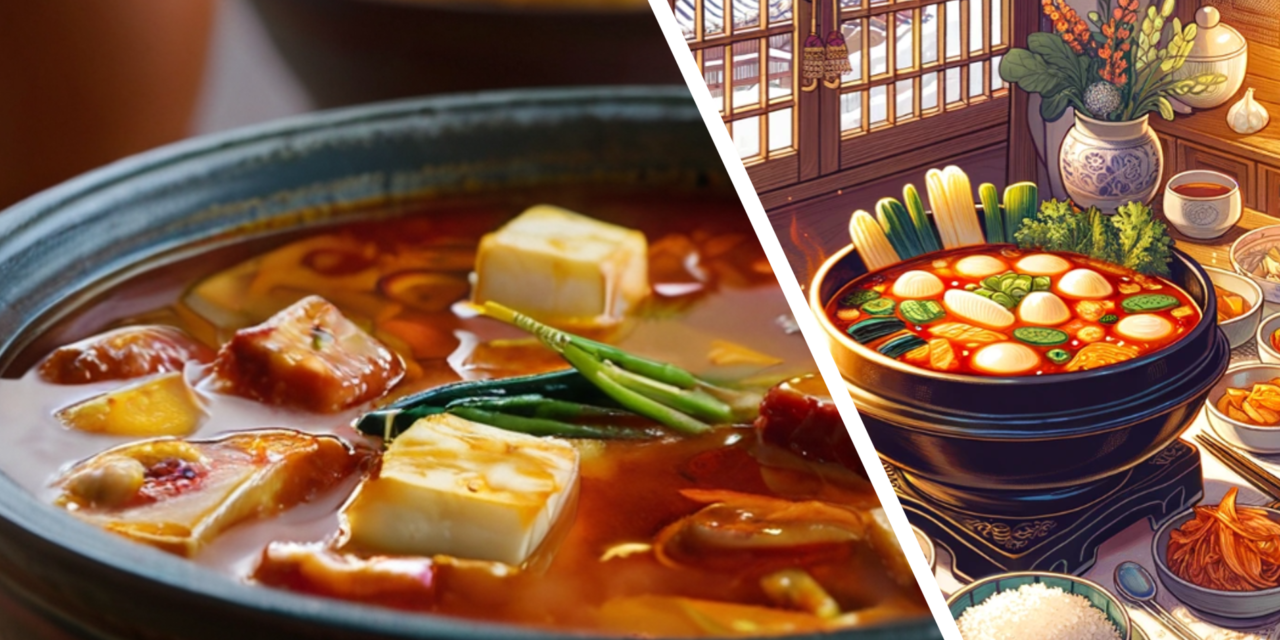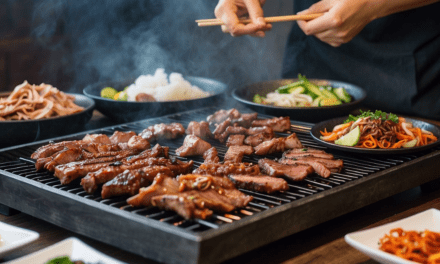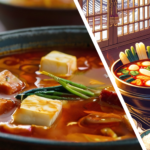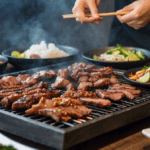📅 게시일: 2024년 03월 28일 | 🔄 수정일: 2025년 02월 10일
Table of Contents
Introduction
Unveiling the Essence of Sundubu-jjigae
Imagine a chilly evening, the kind where you can see your breath in the air, and the thought of something warm and comforting is all that’s on your mind. That’s the perfect setting for Sundubu-jjigae, a spicy Korean soft tofu stew known for its deep flavors, heartwarming heat, and comforting softness. This dish is more than just a meal; it’s an experience, offering a blend of textures and tastes that soothe the soul and excite the palate.
The Historical Roots of This Spicy Delicacy
Sundubu-jjigae holds a special place in Korean cuisine, with its origins tracing back to the Joseon Dynasty. It was during this era that soft tofu began to gain popularity, as its production method spread throughout Korea. However, the Sundubu-jjigae we know today, rich with seafood, meats, and fiery gochugaru (Korean chili powder), is a relatively modern incarnation, reflecting the evolving tastes and culinary creativity of Korea.
The Ingredients That Make It Special
The Soft Tofu – The Star of the Dish
At the heart of Sundubu-jjigae is its namesake ingredient: soft tofu. Unlike the firmer varieties used in other dishes, the tofu in Sundubu-jjigae is silky and almost custard-like in texture. This type of tofu absorbs the flavors of the stew’s base, creating a harmonious blend of spice, savoriness, and subtle soybean taste.
A Closer Look at the Spices and Seasonings
The signature heat of Sundubu-jjigae comes from gochugaru, which imparts a vibrant red color and a complexity of flavor that’s not just about the spice; it’s also about depth. Garlic, green onions, and sometimes a touch of soy sauce or fish sauce add layers of flavor, creating a base that’s rich and multifaceted.
Additional Ingredients: Seafood and Meat Options
While the tofu is undeniably the star, Sundubu-jjigae often features a variety of seafood, such as clams, shrimp, and mussels, which contribute to its rich, oceanic depth. Pork or beef can also be added, offering a savory counterpoint to the softness of the tofu and the stew’s fiery broth.

Regional Variations Across Korea
Korea’s diverse culinary landscape means that many traditional dishes, Sundubu-jjigae included, boast regional variations that reflect local flavors, ingredients, and histories.
The Seoul Style
In the bustling streets of Seoul, Sundubu-jjigae is often served with a greater emphasis on seafood, mirroring the city’s access to fresh coastal produce. The Seoul version might lean towards a slightly sweeter taste, accommodating the urban palate.
The Busan Twist
Busan, a coastal city known for its vibrant seafood market, offers a version of Sundubu-jjigae that’s rich in ocean flavors. Here, the stew is likely to be loaded with shellfish, offering a briny depth that’s as refreshing as the sea breeze.
Vegetarian and Vegan Adaptations
Recognizing the growing global trend towards plant-based diets, many Korean chefs and home cooks have begun to craft vegetarian and vegan versions of Sundubu-jjigae. These adaptations often use mushrooms and other umami-rich vegetables to mimic the savory depth traditionally provided by meat or seafood.
Cooking Sundubu-jjigae at Home
Bringing the warmth and richness of Sundubu-jjigae into your kitchen is a rewarding endeavor. Let’s break down the process into manageable steps.
Essential Cooking Tools and Techniques
To authentically prepare Sundubu-jjigae, a stone or earthenware pot (ttukbaegi) is traditionally used. This pot retains heat exceptionally well, keeping the stew simmering and hot throughout the meal.
Step-by-Step Cooking Guide
Preparing the Ingredients
Start by gently rinsing your soft tofu in cold water. Meanwhile, prepare your seafood or meat, ensuring everything is cleanly trimmed and ready to be added to the stew. Chop your vegetables—garlic, onions, and scallions—and set them aside.
The Cooking Process
- Begin by heating sesame oil in your pot over medium heat. Add your garlic, onions, and the protein of your choice, sautéing until they start to brown.
- Stir in the gochugaru, cooking it briefly to unlock its color and flavor without burning it.
- Pour in your stock (anchovy, beef, or vegetable) and bring the mixture to a boil. Then, add your soft tofu, breaking it into large chunks.
- Once the stew returns to a boil, add your remaining vegetables and adjust the seasoning with soy sauce or salt. Let it simmer until everything is cooked through.
- Serve the stew boiling hot, with a raw egg cracked over the top for diners to stir in, allowing it to cook in the residual heat.
Health Benefits of Sundubu-jjigae
Nutritional Profile
Sundubu-jjigae is not just a feast for the senses; it’s also packed with nutritional benefits. Soft tofu is a great source of protein, calcium, and iron, while the various vegetables and spices add vitamins and antioxidants to the mix.
Diet-Friendly Aspects of Sundubu-jjigae
For those watching their diet, Sundubu-jjigae can be a godsend. It’s naturally low in calories yet filling, making it an excellent option for weight management. Moreover, by adjusting the ingredients, it can easily fit into ketogenic, low-carb, or plant-based eating plans.
Pairing Sundubu-jjigae with Other Korean Dishes
A traditional Korean meal is about balance and harmony. Sundubu-jjigae pairs wonderfully with a variety of side dishes and beverages.
Complementary Side Dishes (Banchan)
Kimchi, with its tangy and crisp texture, contrasts beautifully with the soft and spicy stew. Other popular choices include seasoned spinach, bean sprouts, and cucumber salads.
Beverage Pairings
For beverages, light Korean lagers or soju can complement the stew’s spiciness. Alternatively, barley tea offers a refreshing, palate-cleansing effect.
Enjoying Sundubu-jjigae Beyond the Borders
Finding Authentic Sundubu-jjigae Overseas
Thanks to the global popularity of Korean cuisine, finding authentic Sundubu-jjigae outside Korea has become easier. Look for Korean restaurants that specialize in traditional dishes, or seek out Korean grocery stores for DIY kits and ingredients.
Online Communities and Resources
For enthusiasts eager to learn more or share their Sundubu-jjigae adventures, numerous online forums, blogs, and social media groups offer a treasure trove of information, recipes, and tips for both novices and seasoned cooks alike.
The Cultural Significance of Sundubu-jjigae
Sundubu-jjigae in Korean Media
Sundubu-jjigae frequently appears in Korean dramas and films, underscoring its role as a comfort food that evokes feelings of home and warmth. It’s often portrayed as a dish that brings people together, symbolizing hospitality and shared joy.
Festivals and Culinary Events
In Korea, food festivals offer a fantastic way to experience the country’s culinary diversity. Sundubu-jjigae, with its regional variations, is a popular feature at many of these events, celebrated for its comforting warmth and depth of flavor.
Conclusion
The Enduring Appeal of Sundubu-jjigae
Sundubu-jjigae stands as a testament to the richness of Korean cuisine, offering a symphony of flavors that speaks to both the country’s culinary traditions and its ongoing innovation. Whether enjoyed in a bustling Seoul restaurant, a cozy home kitchen, or anywhere in between, Sundubu-jjigae remains a beloved dish that warms the heart and nourishes the soul.
Your Next Steps in Exploring Korean Cuisine
Having explored the spicy, comforting depths of Sundubu-jjigae, the journey into Korean cuisine is just beginning. Each dish tells a story, each flavor opens a door to a new world of tastes, textures, and traditions. Dive in, explore, and let your palate be your guide to the rich culinary landscape of Korea.








